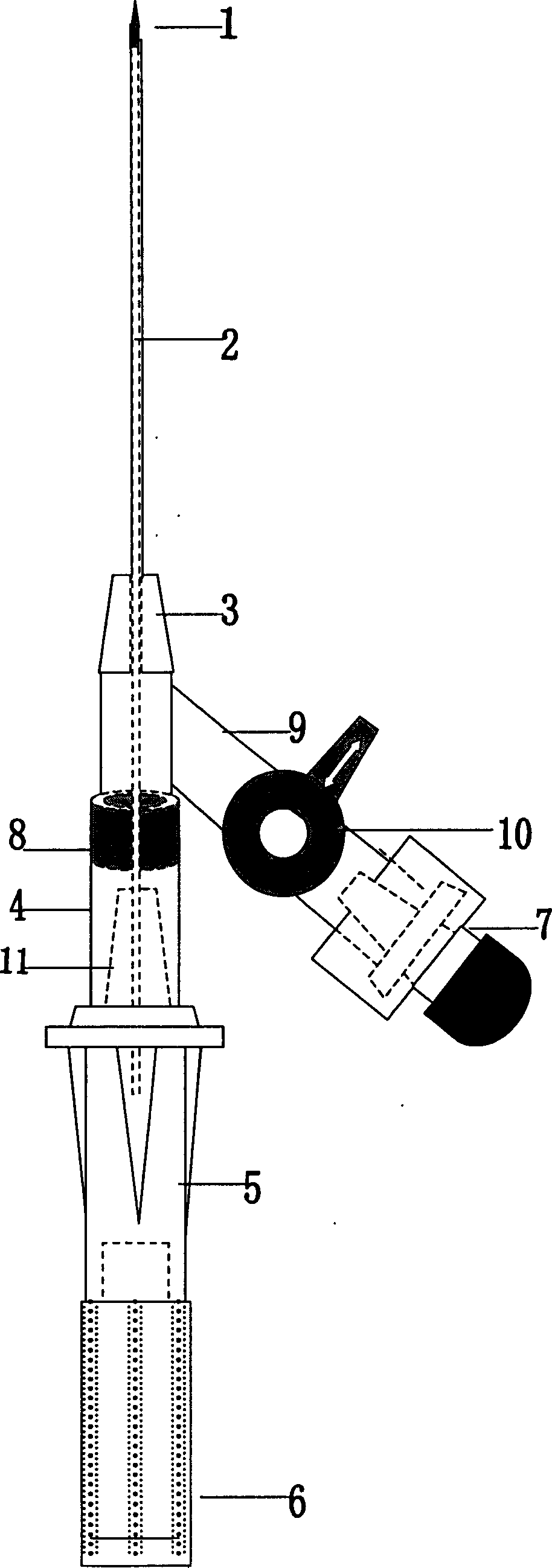Close type needle of retaining on artery
An indwelling needle and closed technology, which is applied in the field of medical devices, can solve the problems of blood polluting the environment and spreading diseases, it is difficult to ensure aseptic operation, and the amount of flushing affects blood coagulation, etc., so as to prevent blood from polluting the environment and blood-borne diseases, and reduce the number of organs. The incidence of embolism and the effect of ease of use and operation
- Summary
- Abstract
- Description
- Claims
- Application Information
AI Technical Summary
Problems solved by technology
Method used
Image
Examples
Embodiment 1
[0032] use figure 2The closed arterial indwelling needle shown is taken as an example by the direct puncture method. The direct puncture method refers to the process in which the arterial indwelling needle penetrates the skin, subcutaneous tissue and arterial vessel wall layer by layer and enters the arterial vessel. Before puncturing, remove the heparin cap 7 at the tail end of the side hole tube 9 for backup, connect the joint of the pressure sensor 12 extension tube 13 to the tail end of the side hole tube, and place the handle switch 10 in a direction parallel to the side hole tube, that is, "ON" state, fill the extension tube 13 of the pressure sensor 12 and the arterial indwelling needle with anticoagulant. Then palpate the arterial pulse, select the skin puncture point, insert the arterial indwelling needle at an angle of 30 degrees to the horizontal plane, and slowly penetrate the skin, subcutaneous tissue and arterial vessel wall layer by layer. Blood return can be ...
Embodiment 2
[0034] use figure 2 The enclosed arterial indwelling needle shown is taken as an example by indirect puncture. Indirect puncture means that the arterial indwelling needle penetrates the skin, subcutaneous tissue and the two-layer vessel wall of the arterial vessel layer by layer, and then returns the arterial indwelling needle into the arterial vessel the process of. The preparation work is the same as in Example 1, and then palpate the arterial pulse, select the skin puncture point, insert the arterial indwelling needle at an angle of 30 degrees to the horizontal plane, penetrate the skin, subcutaneous tissue and the two-layer blood vessel wall of the arterial vessel layer by layer, and then take it out Steel needle core 1, slowly withdraw the trocar 2 into the arterial blood vessel, when it is observed that there is blood rushing from the side hole tube 9 to the pressure sensor extension tube 13 connected with the side hole tube, stop withdrawing the trocar, and put it prop...
Embodiment 3
[0036] use Figure 5 The schematic diagram of the blood collection structure after puncture is shown. Taking arterial blood sample collection as an example, a conventional syringe is connected to the three-way switch on the pressure sensor 12 extension tube 13 before blood collection, and then the anticoagulant in the pressure sensor extension tube is withdrawn to make the artery The blood flows into the extension tube of the pressure sensor from the side hole tube 9, at least to ensure that the arterial indwelling needle before the handle switch 10 is arterial blood without anticoagulant, and the handle switch is placed in the vertical direction with the side hole tube, that is, "off" In the state, sterilize the tail end of the heparin cap, use a conventional syringe 14 with a needle to pass through the heparin cap 7 and the elastic blocking member 8, and reach the main hole tube 4 in front of the elastic blocking member to draw blood back. After blood collection, take out th...
PUM
 Login to View More
Login to View More Abstract
Description
Claims
Application Information
 Login to View More
Login to View More - Generate Ideas
- Intellectual Property
- Life Sciences
- Materials
- Tech Scout
- Unparalleled Data Quality
- Higher Quality Content
- 60% Fewer Hallucinations
Browse by: Latest US Patents, China's latest patents, Technical Efficacy Thesaurus, Application Domain, Technology Topic, Popular Technical Reports.
© 2025 PatSnap. All rights reserved.Legal|Privacy policy|Modern Slavery Act Transparency Statement|Sitemap|About US| Contact US: help@patsnap.com



